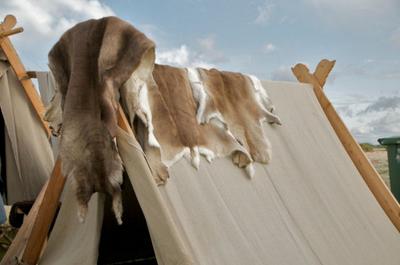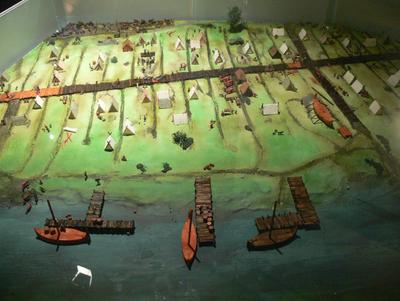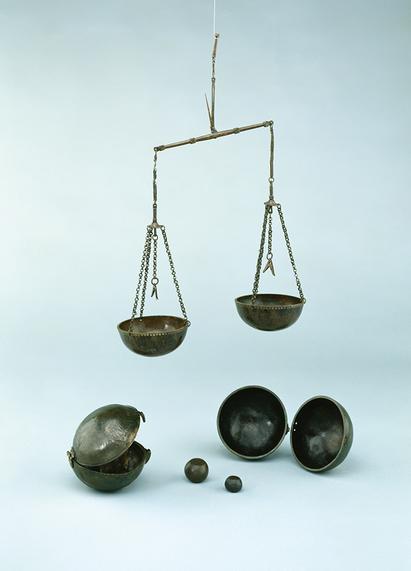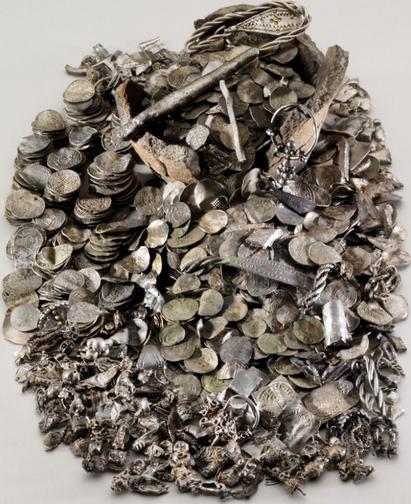Trade in the Viking period

The Viking Age involved more than just violence and conflict. Trade was one of the more peaceful activities undertaken by the Vikings, and one which also flourished during the period. The port of Hedeby in Schleswig, which is located in Germany today, was Denmark’s most important trading centre during the Viking period. Hedeby was surrounded by protective fortifications. Inside the fortifications was a network of streets where merchants and craftsmen were based. They operated under the protection and control of the king.
The origins of the town date back to the 8th century. In the course of the Viking period it grew in size and importance. One of Hedeby’s great advantages was that it was located at a traffic junction of land and water routes.
Ribe was another important trading town in the Viking Age. A trading centre was founded here at the beginning of the 700s on the north side of the Ribe River. Both locations were a vital part of Viking trading networks, although Ribe could not match Hedeby in terms of size and the amount of trading.
Viking trading towns
Before the Viking Age locations were chosen for trading and larger villages existed, but there were no proper towns. At the beginning of the Viking Age, the first proper trading towns developed in Scandinavia. These appeared in central locations along Scandinavia’s coasts, near to natural harbours or on fjords.
Some of the towns were just small markets located on beaches, which grew in size. Others are thought to have been planned and built up according to rigid town plans. The individuals responsible for such projects must have been very powerful individuals, perhaps kings or local magnates.
Such an initiative was involved in the foundation of the trading town of Ribe. At the beginning of the 8th century, a king or a powerful magnate gave permission for merchants to set up their stalls in safety in a field near the Ribe River. In a 200 m x 65 m area a general street was established, with 6-8-metre-wide plots of land on either side. The plots were separated by boundary ditches and planking paths. Prior to this, the ground surface had been covered with a thin layer of sand. Merchants could sail their vessels up close to the trading area, and traders and craftsmen could now walk around on a dry ground surface. Before long the plots were occupied and bustling with activity. To start with the trading centre was only used at certain times of the year and was deserted in the winter.
It was craftsmen and traders in particular who lived in the towns. Here they served a public, which had resources to purchase goods, and the many merchants that streamed in from near and far.
Imported products were distributed further on into local areas from the towns, whilst the locally produced products were sent out into the world. In Jutland, for instance, imported products are often found when Viking Age villages located near to towns are excavated.


Kings and towns

For a town to attract trade, it was crucial that the merchants could trade in peace and feel safe. They would obviously not travel a long distance with valuable goods, if they risked losing their lives and – or – the quantity of goods that they brought with them was large. Protection was therefore required, and the guarantor of this was often the king or local magnate. However, the king could also charge the merchants and craftsmen various duties and taxes, when they were based in the town.
The trading towns of the Viking period were therefore an economic asset to the king. He founded the towns and thoroughly encouraged their development. This may have been why the Danish king Godfrey destroyed the trading town of Reric in North Germany in 808. After the attack Godfrey forced all its tradesfolk and craftsmen to move to the trading centre of Hedeby, and to sell their goods there instead. This was an effective way of removing the competition from Reric and creating more wealth and trading for Hedeby. The king could also gain financially from this, as he could now demand taxes from the influx of new merchants.
At the same time Godfrey apparently also repaired the border fortification known as the Danevirke. The Danevirke was located near Hedeby and formed a boundary between the Danish kingdom and the territory inhabited by the Saxons, which was under Frankish influence. This meant that Hedeby’s inhabitants, as well as visiting merchants, could now feel more secure.
At the end of the 900s King Harald Bluetooth strengthened Hedeby further. He constructed a defensive structure, consisting of a semi-circular earthwork, around the town. From this earthwork the king’s housecarls – his private retinue of warriors – could guard and defend the town against attack. At the same time the harbour was also safeguarded with a boundary of stakes.
At the end of the 1000s Hedeby was attacked several times and trading activity subsequently moved to Schleswig. A contributory factor to this may have been the rising water level in the area, which resulted in a sump at the location. Great quantities of waste in the harbour also made it difficult for the latest vessels to reach Hedeby’s quays. At the same time new trade routes were also becoming more attractive. This marked the end of 300 years of activity at Hedeby.
A safe journey – free trade in the Viking Age
Trading ships and trade centres were attractive targets for plundering and long-distance transportation of goods over land or sea was always a risky business. This is illustrated in a written account about the missionary Ansgar. It describes how whilst on his first missionary expedition to the Swedish trading town of Birka in 830, he was attacked by pirates. Ansgar and the merchants he was travelling with were robbed of all their possessions.
Despite the fact that historical writers are very often preoccupied with wars and battles, the written sources also feature a number of descriptions of diplomatic agreements.
The Annals of Fulda for the year 873 describe how the Danish king Sigfred’s emissaries travelled to Worms to make an agreement with King Louis the German. Their objective was to secure peace in the border areas between the territories of the Danes and the Saxons. Merchants would therefore be able to trade in peace and safety in the neighbouring empire.
Trading agreements testify to peaceful coexistence between countries, but also to the fact that trade could not take place without the protection of kings and agreements between them.
Exchange in the Viking Age
A runic inscription from Hedeby tells us that Oddulfr gave Eyríkr an otter skin and Eyríkr gave Oddulfr a sword. This describes a straight exchange, which was a very common type of transaction in the Viking Age. Many of the exchanges that took place involved surplus farm products. These included cereals, vegetables and domestic animals. They were brought into the towns by farmers and exchanged for necessities, such as clothes or tools, and luxury items, like jewellery and glass.
During the course of the Viking period, silver became a more and more important component of trading. It was a product which could be used for payment according to its weight. Cut-up silver jewellery, ingots and coins have therefore often been found. These were required to make the weight of silver balance in a transaction. Using a set of scales and weights, the amount of silver that was required to complete a deal could be precisely determined. The earliest known Danish coins have been found at Ribe and Hedeby, but coins first began to be used more widely as a method of payment during the 11th century, in the reign of King Sweyn II Estridsen.
What were the goods worth?

According to various written sources, a stirrup could be exchanged directly for a sword or bought for 125 grams of silver. A female slave, on the other hand, cost a cow and an ox. Three cows were equal to a horse, whilst two horses or four male slaves were needed to acquire a suit of chain mail.
This gives us an idea of the value of some of the goods in the Viking Age, although supply and demand also influenced the market then, just as they do today.
